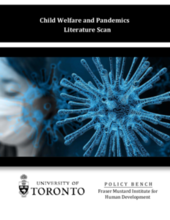On March 11, 2020, Dr. Tedros Adhanom Ghebreyesus, Director-General of WHO classified the COVID-19 situation as a pandemic on the basis of alarming levels of spread and severity, and by the alarming levels of inaction. Since the corona virus first emerged in China’s Hubei province, it has spread to 181 countries, infected 245,888 people globally and killed 10,048. In addition to the tragic human consequences of COVID-19, the United Nation’s trade and development agency estimates that the slowdown in the global economy caused by COVID-19 is likely to cost at least US$1 trillion. Amid the unfolding pandemic, government efforts are underway to contain the virus and mitigate its effects on populations; however, organizations such as child welfare agencies responsible for helping the most vulnerable in society are struggling to provide the necessary supports and services as are children who rely on them for their survival.
This literature scan identifies and synthesizes existing literature examining the effects of pandemics and the identification of policy solutions to mitigate their effects on a well defined group of Canada’s population—children in the care of Canada’s child welfare system. This particular segment of Canada’s population warrants attention for several reasons. First, compared to other developed countries, Canada has an exceptionally high rate of children in care. Second, considered to be among Canada’s most vulnerable population, children in care either have no parents or for a number of different reasons—socioeconomic circumstances, behavioural issues, abuse, family conflict, neglect or parental incompetence—are taken from their parents by the child welfare system or courts. Third, pandemics can significantly limit the capacity of public agencies to operate and provide services and supports to populations during a period of heightened demand and uncertainty. It is especially important for child welfare agencies responsible for vulnerable populations such as abused and neglected children to ensure continuity of care during this period.
A scan of existing literature reveals that children in care are at a heightened risk of harm from not only the current COVID-19 pandemic, but in many cases, from government policies being implemented to contain the epidemic. This includes increased risks of: physical and emotional maltreatment; gender based violence; mental health and psychosocial distress; exploitative labour; separation from caregivers; and social exclusion. Early feedback from key stakeholders— children, youth, parents, foster and adoptive parents, caseworkers, probation officers, judges and others—suggests system resources and capacity are under considerable pressure as agencies and child protection workers struggle to provide services and supports to clients. Child welfare systems and agencies, require policy makers to formulate, articulate and implement child protection strategies that: allow for and encourage increased coordination across all sectors that involve children in care; build on the strengths and positive coping mechanisms of communities, families, caregivers and children; address the challenges of highly venerable populations such as youth in residential care; and provide for the required resources and supports to function not only during an epidemic but also in pre- and post-pandemic environments.

